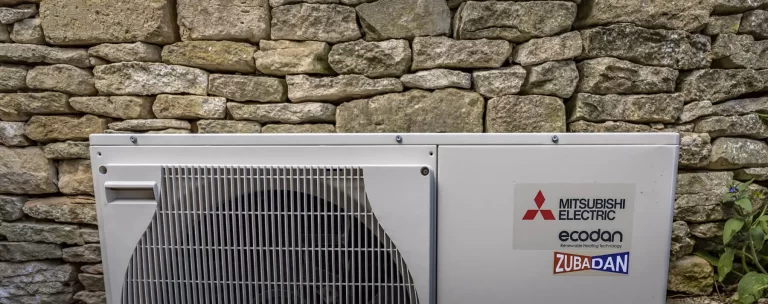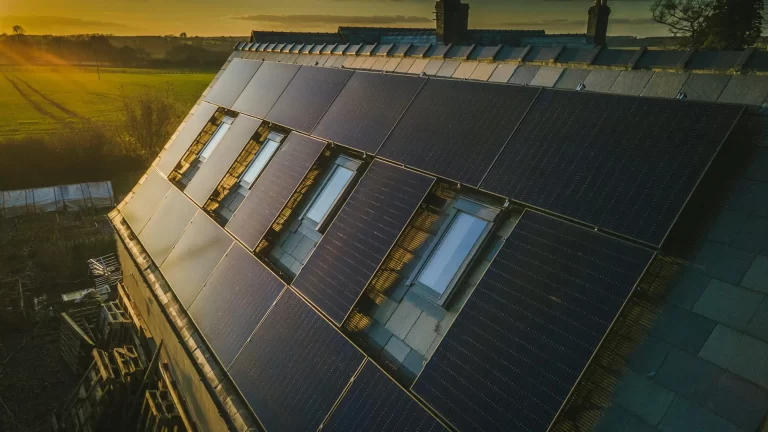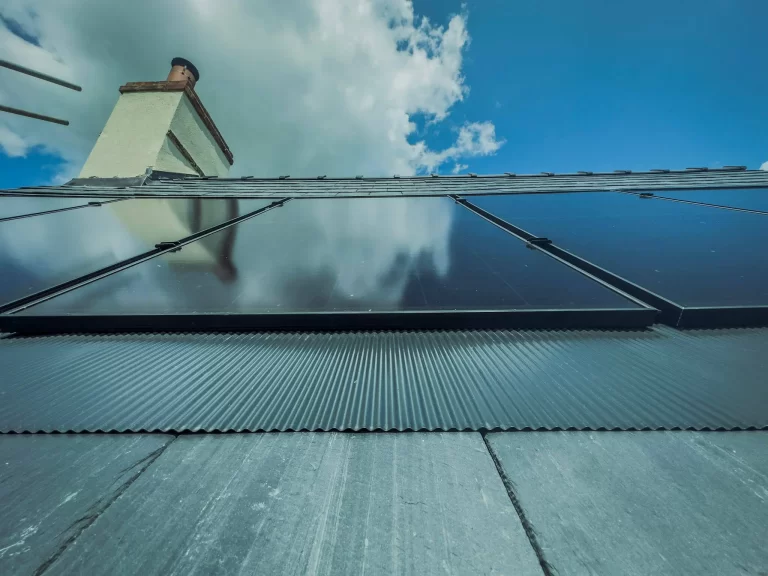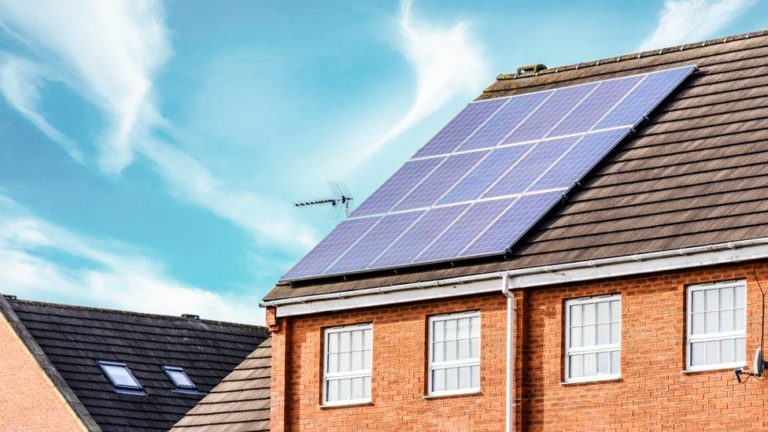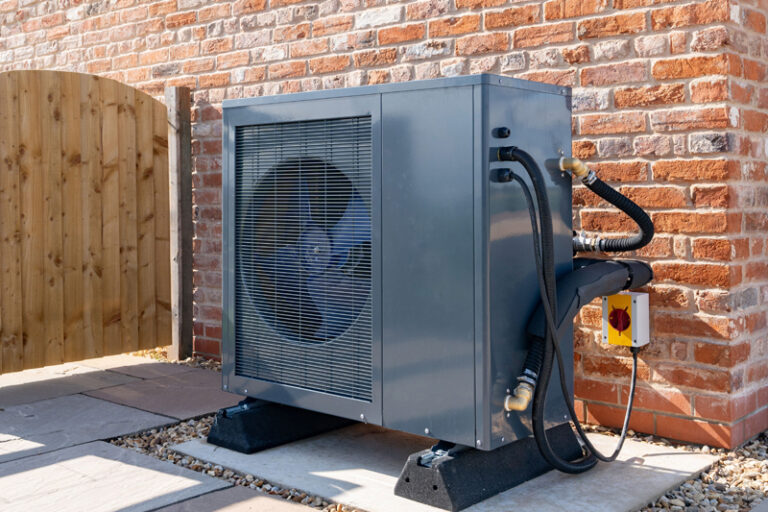Table of Contents
Solar energy is a leading renewable power source that offers a sustainable alternative to fossil fuels. But how efficient are solar panels in converting sunlight into electricity?
Solar panel efficiency refers to the percentage of sunlight that a panel can convert into usable electricity. On average, modern solar panels have efficiency rates between 15% and 22%, but various factors can impact their performance. Understanding these factors, and knowing the efficiency of different types of panels, can help you make informed decisions about your solar energy investment.
What Can Affect the Efficiency of Solar Panels?
External factors can have a big impact on how efficient your solar panels are, which is why it’s so important to try and make these as optimal as possible to get the most out of your system. Some factors that you need to be aware of include:
Angle and Orientation
For optimal performance, panels should be angled to capture the maximum amount of sunlight throughout the day. This angle usually corresponds to the latitude of the installation location, with panels facing true south in the northern hemisphere (or true north in the southern hemisphere) typically receiving the most sunlight. Seasonal adjustments can also help, which means tilting the panels steeper in winter and flatter in summer to optimise the amount of sunlight they capture.
Shade
Shade is one of the biggest efficiency killers for solar panels and even partial shading from trees, buildings, or other obstructions can significantly reduce a panel’s output. Since many solar panels are connected in a series, shade on just one panel can affect the entire array’s performance. Using micro-inverters or power optimisers can mitigate this problem by allowing each panel to operate independently, minimising the impact of shade.
Temperature
While it might seem logical to assume that hotter conditions would be better for solar panels, the opposite is actually true, and higher temperatures can decrease the efficiency of solar panels. Most panels are tested at 25°C (77°F), and their efficiency drops as the temperature rises above this level. This happens because heat increases the panels’ internal resistance, reducing their ability to convert sunlight into electricity, meaning that panels often perform better and more efficiently in cooler climates.
Dirt and Debris
Accumulated dirt, dust, leaves, or bird droppings can block sunlight from reaching the solar cells, which is why regular cleaning and maintenance are essential to ensure that the panels operate at their maximum capacity. Some areas might require more frequent cleaning than others, especially in places with high pollution or frequent dust storms.
Age
Over time, all solar panels degrade and lose efficiency, which is a natural part of the solar panels’ lifecycle, typically occurring at a rate of about 0.5% to 1% per year. After 20-25 years, most panels will still produce energy but at a reduced rate compared to when they were new. This gradual decline in efficiency is factored into the overall design and economics of solar panel installations.
Solar panels degrade primarily due to prolonged exposure to sunlight, temperature fluctuations, and weather conditions. UV light and thermal cycles can deteriorate the Photovoltaic cells and protective components, reducing their energy conversion efficiency. Mechanical stress from environmental factors like wind and debris also contributes to this decline.
What is Solar Cell Efficiency?
Solar cell efficiency measures how effectively a solar cell converts sunlight into electricity, similar to the engine of a car determining its overall performance. Just as driving through towns and frequently changing gears results in lower fuel efficiency compared to maintaining a constant speed of 50-60mph on the motorway, a solar cell’s efficiency varies based on conditions such as light intensity and temperature.
In the case of solar cells, their efficiency tells us how much of the sunlight that hits them gets converted into usable electricity. This efficiency is different from overall solar panel efficiency because a panel’s performance can be influenced by additional factors like the arrangement of cells, the quality of assembly, and external conditions.
Several factors influence solar cell efficiency:
- Material Quality: Higher-quality materials, like pure silicon, allow for better electricity flow and higher efficiency.
- Design and Structure: The way a cell is designed, including its thickness and the type of contacts used, can impact its performance.
- Temperature: Solar cells work best at moderate temperatures, so when it gets too hot, their efficiency drops.
- Light Spectrum: Solar cells are tuned to convert specific wavelengths of sunlight more effectively, which means some parts of the light spectrum are used better than others.
Understanding solar cell efficiency helps us see why some solar panels perform better than others. It’s like knowing how many miles per gallon a car will achieve.
Which Type of Solar Panel is the Most Efficient?
Having the most efficient solar panels installed can make a big difference to the amount of energy generated, especially if you know certain external factors could be working against you. Here’s a closer look at the three main types of solar panels and how they stack up in terms of efficiency:
Monocrystalline Solar Panels
Monocrystalline solar panels are the top performers when it comes to efficiency. Made from a single, pure crystal structure, they usually boast high efficiency rates between 15% and 22%, which comes from the quality of the silicon used, allowing for better electron movement and higher energy conversion. What’s more, their sleek, black look can be a stylish addition to your roof as well as being ideal if you don’t have much space but still want the most efficient solar panel system possible.
Polycrystalline Solar Panels
Polycrystalline solar panels are a bit more budget-friendly and are made from silicon crystals that are melted together, which is a cheaper process but results in slightly lower efficiency, typically between 13% and 16%. This lower efficiency is due to impurities and grain boundaries in the silicon, which slow down electron movement. Polycrystalline panels have a distinctive blue colour and a speckled look, which you may have seen before as these types of panels strike the best balance of cost and efficiency.
Thin-Film Solar Panels
Thin-film solar panels are the least efficient, with rates between 10% and 12%, but they have their own set of advantages. They’re created by layering photovoltaic material onto a substrate like glass, plastic, or metal, making them lightweight and flexible, which opens up a lot of installation options where traditional panels wouldn’t work, such as on curved surfaces or portable solar devices. They also handle higher temperatures and low-light conditions better than the other types.
Understanding Efficiency Rates
Daily Energy Output: When we discuss efficiency rates of solar panels, we refer to the percentage of sunlight that can be converted into usable electricity. For instance, a 20% efficient monocrystalline panel in an area that receives about 5 hours of strong sunlight per day could generate approximately 1 kilowatt-hour (kWh) per day from a 100-watt panel.
This means that the higher the efficiency rate, the more electricity can be produced per square foot of the panel, which is crucial in areas with limited space or in maximising energy production from smaller installations.
How Do Weather Conditions Impact Solar Panel Efficiency?
Different weather conditions can affect how efficiently solar panels work, from the amount of sunlight they get to the physical wear they endure. Here’s a breakdown of how the climate you live in could impact your solar panel efficiency:
Sunlight
Sunny days are the best for solar panels because they provide the most light and the more direct sunlight the panels receive, the more electricity they produce. In places with lots of sunshine year-round, solar panels can generate a lot of energy, though particularly high temperatures will reduce their efficiency somewhat. Areas that often have cloudy or rainy weather will see lower energy production since less sunlight reaches the panels, but that doesn’t mean you should rule out solar panels completely – they can still be very effective even in climates that have a lot of overcast days (like the UK).
Cloudy and Rainy Days
As previously mentioned, cloudy skies can dramatically cut down the amount of sunlight that gets to the panels, reducing their efficiency. On overcast days, solar panels might only produce 10% to 25% of their usual capacity. However, they can still generate some electricity even when it’s cloudy. Rainy days aren’t all bad either, as rain can wash away dust and dirt, which helps keep the panels clean and can actually improve efficiency once the sun comes back out.
Snow and Ice
Snow can be a major hurdle for solar panels, as when snow covers the panels, it blocks sunlight entirely, stopping energy production until it melts or is cleared away. Many panels are designed to let snow slide off more easily, especially if they’re installed at an angle. Ice can cause similar issues, blocking light and potentially causing damage if it leads to cracks or stress on the panels.
Wind
Wind can be both a friend and a foe to solar panels, because on the positive side, wind can help cool the panels, counteracting the negative effects of high temperatures. However, strong winds can also pose a risk, potentially damaging the panels or their mounting systems if they aren’t securely installed. Ensuring panels are well-secured is crucial in windy areas to avoid damage and maintain efficiency.
Humidity
High humidity can be a problem, as it can cause moisture to build up on the panel surfaces, reducing their efficiency. Over time, too much moisture can lead to issues like corrosion or material degradation, especially if the panels aren’t properly sealed. Using advanced materials and coatings can help mitigate these effects, but humidity remains a challenge, particularly in tropical and coastal regions.
Is Solar Panel Efficiency Going to Improve in the Future?
The future of solar panel efficiency looks promising, with continuous advancements in technology and materials driving improvements. Researchers and solar panel manufacturers around the world are investing heavily in developing new methods to enhance the efficiency and performance of solar panels. Here are some key areas where significant progress is expected:
Advanced Materials
One of the most exciting developments in solar technology is the use of advanced materials such as perovskites. Perovskite solar cells have shown tremendous potential, with lab efficiencies already exceeding 25%. These materials are cheaper to produce and can be applied in thin, flexible layers, opening up new possibilities for solar panel applications as researchers overcome challenges related to stability and durability. Perovskite solar cells could revolutionise the industry.
Multi-Junction Cells
Multi-junction cells, which layer multiple types of semiconductors, are another promising innovation. These cells can capture a broader spectrum of sunlight by using different materials that each absorb different wavelengths of light. This technology has already achieved efficiency rates above 40% in laboratory settings and while currently expensive and complex to manufacture, ongoing research aims to make multi-junction cells more affordable and scalable for widespread use.
Bifacial Panels
Bifacial solar panels are designed to capture sunlight on both sides, increasing their overall energy production. These panels can reflect sunlight from the ground or other surfaces, boosting efficiency by up to 30% compared to traditional single-sided panels, and as installation techniques improve and costs decrease, bifacial panels are expected to become more common in both residential and commercial settings.
Improved Manufacturing Techniques
Advancements in manufacturing techniques are also contributing to higher solar panel efficiency. Techniques such as passivated emitter and rear cell (PERC) technology enhance the cell’s ability to capture and retain sunlight, reducing electron recombination and increasing efficiency.
Integration with Energy Storage
Efficiency isn’t just about converting sunlight into electricity; it’s also about how effectively that energy can be stored and used. Integrating solar panels with advanced energy storage solutions, such as next-generation batteries, can significantly improve the overall efficiency of solar energy systems. This integration allows for better management of energy production and consumption, ensuring that solar power can be utilised even when the sun isn’t shining.
Uncertain Timelines but Promising Progress
While the exact timeline for these technologies to become widely available remains uncertain, significant strides are being made towards a more sustainable future. The pace of innovation in solar technology suggests that we may soon see these advanced solutions deployed more broadly, offering more efficient, cost-effective, and versatile solar energy options to a global market.
Solar Panel Efficiency: Key Takeaways
Understanding solar panel efficiency is key to making informed decisions about your own solar panel system. Here are the main points to remember when creating a renewable energy setup with solar panels:
- Overall Efficiency: Look at the efficiency rating of the entire solar panel module, not just individual cells. This will give you a better idea of how much electricity the panel can generate.
- Types of Panels: Monocrystalline panels are the most efficient and suitable for limited spaces. Polycrystalline panels offer a good balance between cost and efficiency, while thin-film panels are less efficient but flexible and versatile.
- Installation Factors: The angle and orientation of your panels, avoiding shading, and regular cleaning can significantly affect solar panel efficiency.
Environmental Conditions: Consider how local weather and temperature variations affect panel performance. Solar panels work best in moderate temperatures and clear conditions.



